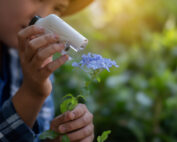Construction of an Outdoor Learning/Flex Space
Scott Fortney
Loudoun County Public Schools
The point of this article is to share the experience of building a high school’s outdoor learning/flex space. Within the High School Environmental Science program, we are always looking for ways for students to reap the benefits of authentic, outdoor learning. We are lucky enough to already have had an outdoor classroom on campus for the last few years. In an effort to expand the use of the outdoor learning experiences in all the curricular areas, we set out to build a new space. We are gladly sharing this experience to help with anyone who might want to try something similar.
Before describing the new outdoor space, it might be best to share about our original outdoor classroom to help explain why we ventured out to make the new space. The first location was started by a student who had a landscaping business. Some of the original framework was abandoned because of a wet seep. It was later picked up and completed by a large group of seniors during the first year of our capstone program and was added to the successive year.
Figure 1
Original Outdoor Classroom

Even though this space gets used by certain classes occasionally, it is difficult to reach. It can be 1/4 of a mile from the school depending on the location of the classroom. This distance requires a big effort on the part of both teachers and students as well as a large portion of class time dedicated to travel.
Keeping these reasons in mind as well as other objectives, we set out to make a new outdoor space. Other considerations included: administrative support, potential uses for the space, what groups/classes may use it, proximity to school (ease of use), materials and money, permissions, permanent vs. non-permanent structure, convenience of maintenance, and last but not least, labor.
Figure 2
New Outdoor Learning/Flex Space

Administrative Support
Administrative support is definitely Step 1 and likely the most important aspect. Be prepared to have an honest discussion with the administrator and be willing to listen to any reluctance or concerns as well as positive feedback, such as locations and uses that you may not have thought of previously. You should have a vision of your outdoor classroom in terms of its uses and who may utilize the space. The more diverse ways the space can be used by various groups, the more appealing it will be to your administrator. Including some research about the advantages of students learning outdoors would also be an important touch.
Potential Uses for the Space
Obviously, we wanted the outdoor classroom to be used for not only classes that may have curriculum related to nature, but for any subject and any teacher willing to take their class outside. We consulted with our counseling department and realized they would love to have an outdoor space, somewhere peaceful to have small group discussions as well as an area they may take students to decompress or to alleviate stress.
The location is adjacent to our nature trail entrance and is useful to stage walking tours and kinesthetic activities with stations. This trail is part of our cross-country course and serves as a view area to observe the landscape. During discussions with our principal, he suggested it would be a suitable outdoor lunch area for teachers (who already use one picnic table in a much less pretty area) as well as a location for special needs instruction.
Proximity to the School
As we learned with our original outdoor classroom, proximity to the school is a must. The bottom line is that if it takes very long to walk to the designated spot, it will just not get used like you had hoped. It will take too much effort to get the students there and focused as well as take a large portion of class time for the movement to and from the location. We were able to place our new outdoor space very close to one corner of the school. The picture of the new classroom shown is actually taken from the top corner of the school. The proximity allowed us to get school Wi-Fi and open up a wider range of activities for the classes.
Materials and Cost
Considerations of materials and cost are both obviously very important in building the outdoor classroom. Our outdoor space originated within the Environmental Science department, so one huge aspect and something that potentially greatly broadens the types and amounts of materials used is reuse supplies. A pillar in environmental circles is reduce, reuse, and recycle. Our outdoor space utilized this concept to a great degree. You have a choice to plan a project and look for materials that you may repurpose in the project, but our project really evolved by noticing materials that were not being used and coming up with a vision to use them.
The resources that were reused or repurposed in this project were two types of cement blocks, a plastic grid floor, and a Wi-Fi tower. The cement blocks have been around for 15 years from the original construction of the school. The blocks had been used in some raised garden beds that had run their course and were being dismantled. The decorative white block was used to hold down weed block, a type of landscape fabric, by counter sinking the material into the ground. This step in the process provided a border for the area and helped hold the benches in place. The cinder blocks were painted and stacked to use for benches/seating areas around the perimeter of the space. The plastic grids, slated to be thrown away, were donated by a church that had renovated and turned gym space into classrooms. The Wi-Fi booster tower had been used during the pandemic, so that students who did not have internet accessibility could come to the parking lot to get access. The booster tower was not being used anymore and was moved to a corner of the building closest to outdoor space and it provides internet access there now.
Figure 3
Repurposed Materials

Permissions and Permanent vs. Non-Permanent
In terms of permissions, and permanence, all locations will vary. In this regard, it is important to work with your administrator to find what limitations, regulations and restrictions may come into play. They will have a better understanding of who you need to see and what you will need to do for approvals. For our space specifically, we went with a non-permanent structure because there are far fewer regulations and permissions needed. Each situation is different. There are no objects cemented down and we did not change the landscape at all, except to cut grass down to the ground. The cinder block benches, stacked with no mortar, are held in place by the treated wood caps. We chose to use 90-degree angles to make the benches steadier, so as not to be knocked over.
Convenience of Maintenance
The convenience of accessing the space and maintenance is something easy to overlook. Only through conversations with our head custodian did this perspective truly come to light. Any outdoor project probably requires some sort of maintenance. Keeping this in mind, the main reason we counter sunk the block around the outside edge was so the mowers can cut over it, and there will be no extra trimming required by the custodial staff. If you choose to do an outdoor space, you may have totally different maintenance issues to consider, but do not neglect to think about them.
Labor
We have had very good success with student volunteers. This classroom, as well as the first space, and our nature trail for that matter, have been done by seniors during their 2-week capstone period. Participating in capstone projects is an option for academically qualifying seniors who may choose to do service projects, internships, or job shadowing in lieu of being in the classroom for the last 2 weeks of their senior year. Students will need guidance, of course, but these learners have skills that may surprise you. Students are always looking for a project to do and get excited as they see their creations come to life. These projects help them develop new skills and makes them feel good about contributing to something authentic– your students may come back in the future and say “I helped do that!”
Share
LATEST RESOURCES
Construction of an Outdoor Learning/Flex Space
Construction of an Outdoor Learning/Flex Space
Scott Fortney
Loudoun County Public Schools […]
Engaging Digital Natives Through Literacy, Outdoor Learning, and Technology
Engaging Digital Natives Through Literacy, Outdoor Learning, and Technology
Erik […]
Pages to Puddles: Story Walks as a Creative Tool for Assessing Stormwater Knowledge
Pages to Puddles: Story Walks as a Creative Tool for […]






